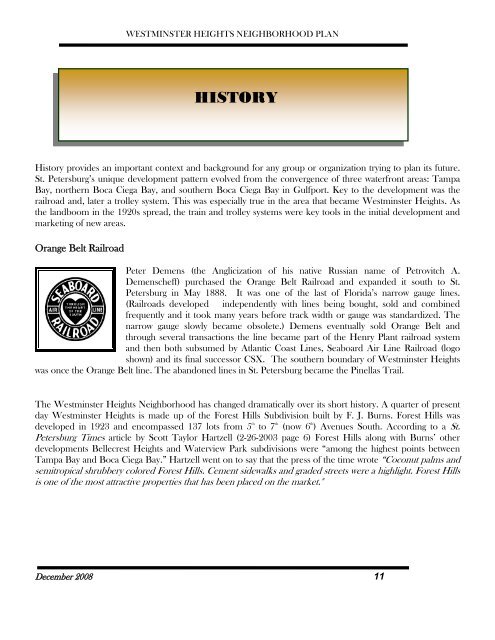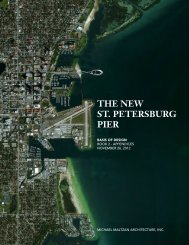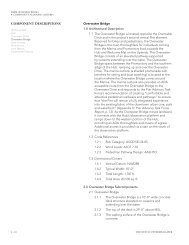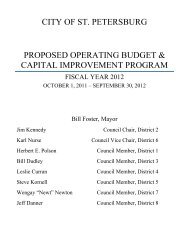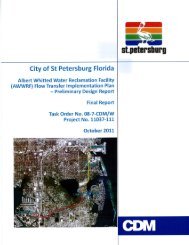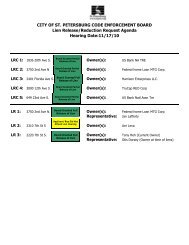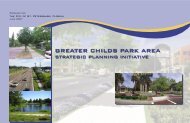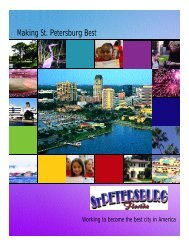Westminster Heights Neighborhood Plan - City of St. Petersburg
Westminster Heights Neighborhood Plan - City of St. Petersburg
Westminster Heights Neighborhood Plan - City of St. Petersburg
You also want an ePaper? Increase the reach of your titles
YUMPU automatically turns print PDFs into web optimized ePapers that Google loves.
WESTMINSTER HEIGHTS NEIGHBORHOOD PLAN<br />
HISTORY<br />
History provides an important context and background for any group or organization trying to plan its future.<br />
<strong>St</strong>. <strong>Petersburg</strong>’s unique development pattern evolved from the convergence <strong>of</strong> three waterfront areas: Tampa<br />
Bay, northern Boca Ciega Bay, and southern Boca Ciega Bay in Gulfport. Key to the development was the<br />
railroad and, later a trolley system. This was especially true in the area that became <strong>Westminster</strong> <strong>Heights</strong>. As<br />
the landboom in the 1920s spread, the train and trolley systems were key tools in the initial development and<br />
marketing <strong>of</strong> new areas.<br />
Orange Belt Railroad<br />
Peter Demens (the Anglicization <strong>of</strong> his native Russian name <strong>of</strong> Petrovitch A.<br />
Demenscheff) purchased the Orange Belt Railroad and expanded it south to <strong>St</strong>.<br />
<strong>Petersburg</strong> in May 1888. It was one <strong>of</strong> the last <strong>of</strong> Florida’s narrow gauge lines.<br />
(Railroads developed independently with lines being bought, sold and combined<br />
frequently and it took many years before track width or gauge was standardized. The<br />
narrow gauge slowly became obsolete.) Demens eventually sold Orange Belt and<br />
through several transactions the line became part <strong>of</strong> the Henry <strong>Plan</strong>t railroad system<br />
and then both subsumed by Atlantic Coast Lines, Seaboard Air Line Railroad (logo<br />
shown) and its final successor CSX. The southern boundary <strong>of</strong> <strong>Westminster</strong> <strong>Heights</strong><br />
was once the Orange Belt line. The abandoned lines in <strong>St</strong>. <strong>Petersburg</strong> became the Pinellas Trail.<br />
The <strong>Westminster</strong> <strong>Heights</strong> <strong>Neighborhood</strong> has changed dramatically over its short history. A quarter <strong>of</strong> present<br />
day <strong>Westminster</strong> <strong>Heights</strong> is made up <strong>of</strong> the Forest Hills Subdivision built by F. J. Burns. Forest Hills was<br />
developed in 1923 and encompassed 137 lots from 5 th to 7 th (now 6 th ) Avenues South. According to a <strong>St</strong>.<br />
<strong>Petersburg</strong> Times article by Scott Taylor Hartzell (2-26-2003 page 6) Forest Hills along with Burns’ other<br />
developments Bellecrest <strong>Heights</strong> and Waterview Park subdivisions were “among the highest points between<br />
Tampa Bay and Boca Ciega Bay.” Hartzell went on to say that the press <strong>of</strong> the time wrote “Coconut palms and<br />
semitropical shrubbery colored Forest Hills. Cement sidewalks and graded streets were a highlight. Forest Hills<br />
is one <strong>of</strong> the most attractive properties that has been placed on the market."<br />
December 2008 11


